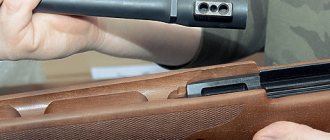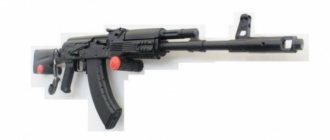Diagram and design of the IMP mine detector
Mine detector device
The main design elements of the mine detector are (Fig. 1): search element 1 with a shortened rod elbow;
amplifier block 2; rod 3; telephones 4; canvas bag 5; transport packaging 6. The search element (Fig. 2) is a cylindrical plastic case 1, inside of which the generating and receiving coils are fixed to a rigid frame and the electrical circuit of the low-frequency oscillation generator is mounted.
The search element is articulated with the rod using a clamp 2 enclosing the body of the search element and a shortened rod elbow 3 with a fork 4 pivotally rotating in the clamp clamp.
Rice. 1. IMP mine detector:
1 — search element with a shortened rod elbow; 2 — amplifier block 3 — rod; 4 - telephones; 5 — canvas bag; 6 — transport packaging
Rice. 2. Search element of the IMP mine detector:
1 - plastic body; 2 - clamp; 3 - shortened rod elbow; 4 - articulated fork; 5 clamping screw; 6 - connecting cable; 7 — cable chip
The angle of inclination of the search element relative to the rod can be changed and is fixed using a clamping screw 5.
The search element is connected to the amplifier unit using cable 6, ending with plug connector 7; The search element has a transverse stripe painted with white paint.
The amplifier unit (Fig. 3) has a metal case 2 with a hinged bottom cover 1, inside of which, on a rigid chassis 3, there is a board 4 with an electrical circuit of the amplifier, a compensator 5, and in a separate compartment 6 - power supplies 7 for the mine detector.
Rice. 3. Reinforcing unit of the IMP mine detector:
a - amplifier unit in the housing, b - internal structure; 1 — hinged cover; 2 - body; 3 — chassis; 4 - amplifier board; 5 - compensator; 6 — compartment for current sources; 7 - power supplies; 8 — power switch; 9 — axle box of the plug connector; 10 — axle box plug; 11 — sockets for turning on telephones; 12 — compensator handles; 13 - protective bracket
On the top panel of the amplifier block there are:
- toggle switch 8 for turning on the mine detector with the inscriptions “On”, “Off”;
— axle box 9 for connecting the cable from the search element; in the transport position, the axle box is closed with a screw-on figured plug 10;
— sockets 11 for turning on telephones, marked “T”, “+”, and “-”;
— two knobs 12 for adjusting the mine detector (knobs for compensators), protected by a bracket 13.
On the side (narrow) walls of the case there are rings for attaching the unit to the shoulder strap.
Four 1,6-FMTs-U-3,2 elements connected in series are used as current sources in the mine detector.
The mine detector rod consists of a shortened elbow, located on the search element, and three separate tubular elbows that are screwed together. The rod has spring clips for fastening the cable connecting the search element to the amplification unit.
In one elbow of the rod, which has a knurled plug, there is a screwdriver.
The mine detection signal indicator is TA-4 phones with a rigid adjustable headband, rubber plugs and a cable ending in a plug.
The canvas bag is used for stowing and carrying the amplifier unit during the search process. The bag is equipped with a shoulder strap and loops for attaching to a waist belt.
The transport package, adapted to be carried in the hands or in the “behind the back” position, is intended for stowing and transporting all elements of the mine detector.
The package body contains a handle and locks for attaching shoulder straps. Inside the metal case there are holders designed to fix the position of individual elements of the mine detector.
Electrical circuit of the IMP mine detector
The electrical circuit of the mine detector (Fig. 4) is based on: a low-frequency voltage generator; compensator; low frequency resonant amplifier.
The low-frequency voltage generator is made according to a push-pull circuit using two P13B semiconductor triodes (3 and 5). The oscillatory circuit of the generator consists of the inductance of the generator coil 6 of the search device and a constant capacitor 7. Resistances 1 and 4 determine the DC operating mode of the generator.
The compensator, intended for setting up a mine detector, is assembled according to a double bridge circuit, consisting of two variable resistances 14 and 15, a constant resistance 12 and a constant capacitor 13. Compensation of the voltage supplied to the amplifier input from the receiving coils is carried out due to the voltage removed through the compensator from a low frequency voltage generator. This voltage can be regulated by changing the value of variable resistances 14 and 15 included in the arms of the bridge.
The resonant amplifier is assembled on three P13B semiconductor triodes (31, 32 and 33).
Rice. 4. Schematic diagram of the IMP mine detector:
1 - resistance ULM-0.120-5.7 kom; 2, 8 — receiving coils; 3, 5, 31, 32, 33 — planar germanium triodes P13B; 4 - resistance ULM-0.120 - 680 ohms; 6 — generator coil; 7 — capacitor MBM-150-1 μF: 9, 10 — capacitors EM-10-15 μF; 11 - resistance BC-0.25-30 ohm; 12 - resistance MLT-0.5-4.7 Mohm; 13 — capacitor KDM-27 pf; 14 — resistance SP-47 com; 15 — resistance SP-22 com; 16 — toggle switch; 17, 18, 39, 42, 44, 47, 49 — capacitors EM-25 uF; 19, 20 — resistance MLT-0.5-1.5 kom; 21 — resistance MLT-0.5-200 ohm; 22, 38, 48 - resistance MLT-0.5-1.8 kom; 23, 25 — matching transformers; 24, 40, 45, 50 - MLT-0.5-3.3 com; 26 — resistance MLT-0.5-4.7 kom; 27, 28, 29 — capacitors 6M2-4700 pf; 30 — telephone sockets; 34 — input transformer; 35 — capacitor MBM-150-0.5 μF; 36, 51 capacitors BM-2-3300 pf; 37 — capacitor BM-2-0.01 μF; 41 — capacitor BM-2-1000 pf; 43 — resistance MLT-0.5-820 ohm; 46 — capacitor BM-2-680 pf; T - telephone; B - batteries; ШР - plug connector
The voltage from the receiving coils of the search device is supplied to the first stage of the amplifier through the input transformer 34. The resonant circuit of the first stage, tuned to the frequency of the generator, consists of the inductance of the matching transformer 23 and a constant capacitor 27.
The second stage of the amplifier is assembled according to a circuit similar to the circuit of the first stage. The resonant circuit of the second stage consists of the inductance of the matching transformer 25 and a constant capacitor 28.
Constant resistances 22, 38 and 40 of the first stage, 24, 43 and 45 of the second and 26, 48 and 50 of the third stage stabilize the operation of the amplifier during possible fluctuations in ambient temperature. Electrolytic capacitors 39 and 44 serve to decouple DC and AC circuits. Capacitors 41 and 46 block triodes 31 and 32 at high frequency.
The voltage from the receiving coils, amplified by the first and second stages, is supplied to the third, output stage, the load of which is a resonant circuit consisting of the inductance of the TL-4 telephone coils and a constant capacitor 29.
Capacitors 17, 18, 42 and 47, as well as resistances 19 and 20, serve to decouple AC circuits and reduce the gain of the amplifier in order to prevent its self-excitation. Resistors 11, 21 and capacitors 9 and 10 serve to eliminate the connection between the generator and the amplifier through current sources.
When the current sources are turned on, the low frequency voltage generated by the generator is supplied to the generator coil 6 of the search device. Alternating current flowing through the winding creates an electromagnetic field around the generator coil, due to which an alternating electromotive force (EMF) is induced in the receiving coils. The windings of the receiving coils are connected to each other so that the EMF induced in them is directed towards them. Since the electrical characteristics of the receiving coils cannot be practically the same, additional equalization of the EMF induced in them is carried out using a compensator.
If there is no metal (mine) under the search device, the value of the difference EMF of the receiving coils is close to zero and no signal is received at the input of the amplifier.
When metal (mine) gets under the search element, the electromagnetic field of the generator coil is distorted, and therefore its inductive coupling with the receiving coils changes. This leads to the fact that the magnitude of the difference EMF of the receiving coils increases significantly. The difference EMF from the receiving coils is supplied to the input of the amplifier, amplified by it and heard by the operator in the telephone in the form of a noticeable increase in sound volume at a constant frequency.
Preparing the mine detector for work
Installation of current sources
To install current sources you need:
— open the lid of the transport package and remove the amplifier unit from the package;
— check the elements 1,6-FMTs-U-3,2 for shelf life and compliance with the operating season; elements suitable for installation in a mine detector are those that have passed no more than 10 months from the date of release;
— use a knife to clean their contacts and bottom part to a metallic shine;
— open the lower hinged cover of the unit housing and install the prepared elements into the power compartment in accordance with the diagram shown on the bottom wall of the unit chassis: two elements are sequentially placed in the right half of the power compartment with the cap down, in the left half - with the cap up;
— close the cover of the amplifier unit, place the unit in the transport packaging and close the packaging lid.
Assembling a mine detector for operation in a standing position
To assemble a mine detector you need:
— open the lid of the transport package;
- remove phones from the packaging and put them on your ears;
— remove the canvas bag and the amplifier unit, place the unit in the bag and put the bag on your shoulder;
— remove the rod elbows from the packaging and screw them together;
— remove the search element, close the lid of the transport package, articulate the rod with the shortened elbow on the search element;
— select the angle between the search element and the rod so that when searching, the search element moves parallel to the ground surface; fix the position of the search element using the clamping screw;
— lay the cable from the search element into the spring clamps on the rod;
— unscrew the figured plug of the axle box on the amplifier block, align the slot on the chip with the protrusion on the axle box and attach the chip to the axle box; screw the connector union nut all the way;
— connect the telephone plug to the sockets on the panel of the amplifier unit;
— move the toggle switch for turning on the mine detector to the “On” position.
In this case, the sound of a constant stomp should appear in the phones.
A view of the mine detector assembled for operation in the “standing” position is shown in Fig. 5.
Rice. 5. IMP mine detector, prepared for operation in a standing position
Assembling a mine detector for operation in the prone position
To assemble a mine detector you need:
— open the lid of the transport package;
— remove the phones from the packaging and put them on your ears;
— remove the canvas bag and the amplifier unit, put the amplifier unit in the bag;
- secure the canvas bag on the right side with waist and shoulder straps so that it does not restrict movement when crawling;
— remove the search element from the packaging;
— rotate (approximately 180°) the shortened elbow of the rod so that its longitudinal axis is parallel to the axis of the search element; fix the position of the shortened knee with a clamping screw;
- articulate the upper elbow of the bar with the shortened knee (an elbow with a plug and knurling at the end);
— secure the cable from the search device in the spring clamp on the rod;
— attach the cable chip from the search element to the axle box on the amplifier block, to do this, unscrew the shaped plug, align the slot on the chip with the protrusion on the axle box, insert the chip into the axle box and tighten the connector union nut until it stops;
— plug the telephones into the sockets on the top panel of the amplifier unit so that the wire from the plug to the telephones passes behind the back;
— move the toggle switch for turning on the mine detector to the “On” position. In this case, a constant tone sound should appear in the phones;
— close the lid of the transport package.
A view of the mine detector assembled for operation in the prone position is shown in Fig. 6.
Rice. 6. IMP mine detector, prepared for operation in the prone position
Setting up a mine detector
When setting up, the search element of the mine detector is located at a distance of 10-20 cm from the ground surface so that there are no foreign metal objects in an area with a radius of 1-1.5 m from it, and adjacent working mine detectors are located no closer than 6 m.
By rotating both knobs of the compensator alternately (in any order), we achieve a gradual weakening of the volume of the control tone heard in telephones, and then its complete disappearance. In this case, only a weak sound of a higher frequency than the main control tone should be heard in telephones.
The correct setting is checked by bringing the search element closer to any metal object (screwdriver, knife). If at the same time a basic tone sound appears in the phones with increased volume, the mine detector is configured correctly.
If, when you bring the search element close to a small metal object, the sound in the phones first weakens and then its volume begins to increase, the mine detector has been configured incorrectly. In this case, you need to reconfigure the mine detector.
If by alternately rotating both knobs of the compensator it is not possible to achieve the disappearance of the fundamental tone heard in telephones, you must:
— use a screwdriver to loosen the screws securing the compensator handles to the axles;
— rotate the axis of the compensator handles with a screwdriver one by one until the fundamental tone disappears in the phones;
— secure the compensator handles to the axles with screws;
— further adjustment of the mine detector is carried out by alternately rotating the compensator.
Having finished setting up the mine detector, you need to recheck it and make sure it is correct.
When setting up a mine detector, you must remember that its sensitivity is determined by the thoroughness of the settings. Therefore, when setting up, you should achieve the lowest volume of the control tone in phones.
Using a mine detector
When searching for mines, the sapper, moving in a given direction, continuously moves the search part of the mine detector in front of him to the right and left above the ground so that the search element is located parallel to the ground surface at a height of 5-7 cm (Fig. 7 and 8).
The width of the terrain, checked during one approach, is:
when working in a standing position 1.7 m; when working in a lying position up to 1 m.
Rice. 7. Search for mines using an IMP mine detector in a standing position
Rice. 8. Search for mines using an IMP mine detector in the “lying” position
After several movements of the search element to the right to the left over the surveyed area, the sapper moves forward to a distance of no more than 30 cm. It is necessary to carefully ensure that during the search there are no areas left that have not been surveyed by the search element.
Having recorded a change in the control tone in the phones, the sapper must stop and clarify the location and nature of the detected object.
To clarify the location of an object, it is necessary to move the search element over the area where the greatest change in the volume of the control tone was recorded, forward (in the direction of movement during the search). If, during such a movement, the sound volume in the phones first gradually decreases, and then, having passed through a minimum, begins to increase again, then at the moment of the lowest sound volume in the phones, the desired object will be in the ground exactly under the white stripe applied to the body of the search element.
If, when moving forward, the transition of the signal through the minimum is not detected, it is necessary to move the search element back in the same place and, in the same way as mentioned above, find the exact position of the desired object in the ground.
Having specified the location of the detected object, you need to use a probe to determine which object was detected. If the discovered object turns out to be a mine, then, depending on the task at hand, the sapper either neutralizes and removes it, or marks it with a special sign.
If it is determined that the signal was caused by a non-explosive metal object, the sapper continues the search, moving in the given direction.
During the search process, the sapper must periodically check the settings and adjust the mine detector.
Upon completion of mine search work, you must:
— disconnect the search element cable plug from the axle box on the amplifier block, screw a figured plug onto the axle box;
— clean the rod and search element from dust (dirt) and wipe dry;
— open the lid of the transport package;
— unscrew the rod elbows one by one, releasing the cable from the clamps, and place them in the transport packaging;
— loosen the clamping screw and turn the shortened elbow of the rod so that it is adjacent to the body of the search element; place the search element in the packaging;
- remove the canvas bag from your shoulder, remove the amplifier unit from it and place it in the package;
— place a canvas bag in the packaging;
- remove the headphones, wrap the cable around the headband and place the phones in the packaging on top of the canvas bag;
— close the lid of the transport package.
All elements of the mine detector must be placed only in the places designated for them.
For possible malfunctions of the mine detector and methods for eliminating them, see table. 1.
If there are other malfunctions, mine detectors should be sent to a workshop for repair.
Mine detector kit, see table. 2.
Table 1. Possible malfunctions of the mine detector and ways to eliminate them
| Characteristic symptoms of a malfunction | Cause of malfunction | Troubleshooting method |
| 1. You can hear rustling and crackling noises on phones | 1a. Poor contacts at the junction of current sources 1b. Poor contact in the plug connector | 1a. Check the connection points of the elements and clean contacts 1b. Check and clean the contacts of the plug connector |
| 2. When the toggle switch is turned on, the mine detector does not work (no sound in phones) | 2a. Power supplies are turned on incorrectly 2b. 2V power supplies are used up. Break in the wire or coils of telephones 2g. Break in the windings of the amplifier transformers | 2a. Check that the power supplies are turned on correctly. Turn them on in accordance with diagram 2b. Replace power supplies with fresh 2V ones. Replace phones with working ones 2g. Open the amplifier. Check the integrity of the transformer windings with an ohmmeter. If the windings are broken, replace the transformer. If a break occurs at the place where the wires are soldered, solder |
| 3. When you tap on the amplifier block, the sound in the phones is interrupted | 3. Bad contacts in the places where the amplifier circuit and axle box are soldered | 3. Check the condition of the soldering of the amplifier and axle box. Solder the faulty solders |
| 4. When rotating the knobs of the amplifier unit, it is not possible to reduce the volume of the main tone in phones | 4a. Open circuit in the circuit of the receiving coils of the search device 4b. Lost contact in the 4V plug connector. Loss of contact between variable resistances and circuit elements of the amplifier block | 4a. Remove the casing of the search element and check the soldering joints of the receiving coils to the wires of cable 4b. Disassemble the plug connector, check and eliminate the fault in the 4V contacts. Remove the casing of the amplifier unit and check the condition of the contacts. In case of contact failure, carefully solder the connection points to the elements of the amplifier circuit |
Table 2. Mine detector kit
| No. by por. | Name of items | Unit | Quantity |
| 1 | Search element with shortened rod elbow | PC. | 1 |
| 2 | Amplifier block | PC. | 1 |
| 3 | Collapsible rod with three elbows | PC. | 1 |
| 4 | Headphones TA-4 with hard headband and rubber plugs | PC. | 1 |
| 5 | Canvas bag with shoulder strap | PC. | 1 |
| 6 | Metal transport packaging with two shoulder straps | PC. | 1 |
| Spare parts and accessories | |||
| 7 | Screwdriver | PC. | 1 |
| 8 | Elements 1,6-FMTs-U-3,2 | PC. | 4 |
| Documentation | |||
| 9 | Operating instructions for the IMP mine detector | PC. | 1 |
| 10 | Form | PC. | 1 |
New mine detector for the Russian engineering troops - non-linear type locator NR900EK "KORSHUN"
IRFS units stationed in the Southern Military District began full-scale work to clean up the territory of the Shelkovsky and Grozny districts in the Republic of Chechnya. IRFS military personnel underwent special training in the Moscow region in April 2011. Work on demining the territory of Chechnya by engineering and sapper units began in March last year. Work has already been carried out in the Kurchaloevsky, Shalinsky and Urus-Martan districts. Complete cleanup of the territory of the republic will continue for three years, the work will end in 2015.
IRFS personnel received new Korshun mine detectors, with the help of which mine clearance will now be carried out much faster. He will have to carry out mine clearance together with the rest of the engineering and special units, a total of more than 16 thousand hectares of agricultural land and more than 7 thousand forest land.
Personnel go out to clear mines in groups. So far, more than 30 hectares have been checked and cleared near the village of Gikalo. During demining itself, personnel work in pairs. The first sapper is engaged in detecting explosive objects, the second sapper is engaged in their neutralization. If it is impossible to neutralize an explosive object, it is destroyed on the spot by detonation. If it is possible to safely move objects, they are collected in one place and detonated using an overhead charge. All work is carried out with the support of local authorities. It is reported that in total it is necessary to clear at least 24,000 hectares of various explosive objects on the territory of the Republic of Chechnya.
A little earlier, the leaders of the republic showed their dissatisfaction with the fact that the federal center did not resolve the issues of demining the territory of Chechnya. According to data available to the leaders of the republic, during two military conflicts on the territory of Chechnya, more than 4,000 people were blown up by landmines and mines, of which 2,170 people died, almost 150 of whom were children. Last year, about 20 more people were injured.
Nonlinear locator NR900EK “KORSHUN”
The main purpose of the Korshun mine detector is to detect explosive objects with electronic filling that are located in the top layer of soil, on the ground, in building materials/structures, and snow.
Using the locator it is possible to detect:
— transceiver radio devices used as an alarm system, communication system and remote control for various explosive objects; — electronic and electromechanical timers for GP; — acoustic, magnetic, optoelectronic sensors installed on the GP; — TV-video-photo cameras; — hidden structures and devices that may be used in conjunction with the GP; — maximum effect when determining the electronic component of various objects; — ski equipment in snow avalanches and rubble.
Features of the mine detector:
— the number of false alarms from various objects has been reduced using the latest highly sensitive 2-channel receiving device (2-3 harmonics); — the risk of missing an explosive object when turning the search antenna is resolved by using an antenna with circular polarization; — for optimal adjustment of devices for various electromagnetic oscillations, stepwise adjustment of the receiver sensitivity is used; — to increase the safety of using the mine detector, the transmitter is equipped with the ability to regulate the power of the probing signal; — to carry the mine detector, the kit includes a backpack in which blocks are placed during use; — for ease of use and operation, all equipment is combined into an ergonomic design; — long-term operation of the mine detector is ensured by a nickel-cadmium battery “5NKGTS-7-1”; — to charge the battery, the mine detector kit includes a charger; — the mine detector body is dust- and moisture-proof and ensures operation in a wide temperature range; — has a large detection range of electronically filled explosives (almost 30 meters); — ensures detection of GPs even behind obstacles;
In addition, the HP900EK KORSHUN Locator provides increased performance compared to existing mine detectors, is lightweight, has a modern appearance, is easy to operate, and conveniently displays the information received. The designers ensured safe use of the device, long-term use during intensive work on one battery, and operation in various field conditions.
Main characteristics:
— operating frequency – 848 MHz; — output pulse – from 30 to 200 W; — sensitivity – 150 dB/W; — detection – light and sound signal; — battery – “Ni-Cad” type; - voltage used - 6V; — battery capacity 7A/h; — current consumption up to 500mA; — the time required to put the device into working condition is about 10 minutes; — battery life is about 8 hours; — temperature range – (+50) – (-30) degrees; — weight of the device when in use is 5.1 kilograms; — set weight – 13 kilograms; — the weight of the instrument unit when in use is 900 grams.
Sources of information: https://www.bnti.ru/des.asp?itm=3994&tbl=02.07.04 https://www.youtube.com/watch?v=sT29yLYZLH0 https://kavkasia.net/Russia/2012 /1338597828.php











